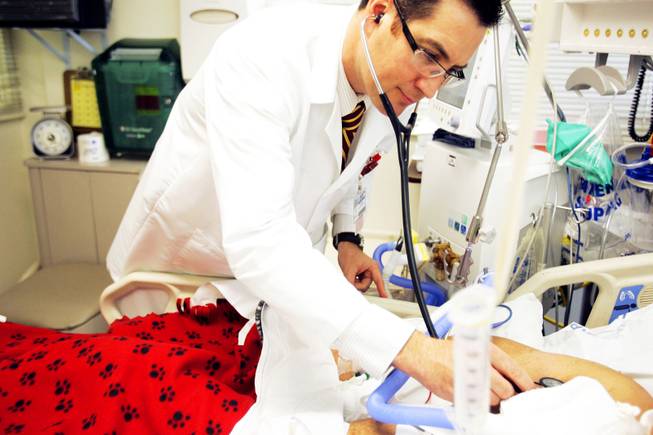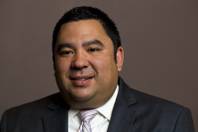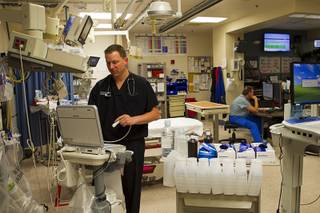
Dr. Oscar Ingaramo is a pediatric intensive care doctor at UMC seen examining a patient Wednesday, April 6, 2011.
Monday, Oct. 13, 2014 | 2 a.m.
University Medical Center is sick.
Finding a prescription to make the public hospital financially viable has vexed executives and politicians for more than a decade, and over the past year, UMC’s problems have grown even more acute.
The Affordable Care Act blew a $15 million hole in the hospital’s budget, and a delay in reimbursements for new Medicaid patients required UMC to borrow $45 million in emergency loans from Clark County to make payroll. The hospital, owned by Clark County, had two rounds of layoffs affecting 390 positions and announced it would close four clinics.
Amid the crisis, the hospital appointed a new CEO, Lawrence Barnard, and a new governing board. Their job is to turn around the troubled hospital and make it self-supporting without a Clark County subsidy.
It’s a big challenge and one that public hospitals across America have been tackling for years.
Finances

University Medical Center's new CEO Lawrence Barnard Monday, May 12, 2014.
New Leadership:
Lawrence Barnard
He was named UMC’s interim CEO in January after Brian Brannman left for an executive position at Dignity Health-St. Rose Dominican. Barnard was given the full-time job in February.
A West Point graduate, Barnard peppers his speeches with military anecdotes. He also has an MBA from the University of Southern California.
Prior to joining UMC in 2012, he worked as an administrator at Summerlin and Valley hospitals. At 35, he is the youngest CEO at UMC in at least 15 years.
UMC’s biggest problem is its defining feature. It’s the safety net for Las Vegas’ poor and uninsured. That means the hospital provides medical care for which it is paid just pennies on the dollar, or not paid at all. The hospital wrote off 16 percent of its gross charges as charity care in 2013, twice the average of other Las Vegas hospitals.
The Affordable Care Act also has led to painful side effects. Thousands of patients who received medical care through Clark County Social Services moved into Medicaid. And Medicaid reimburses the hospital at a rate 30 percent lower than social services. The shift cost the hospital about $15 million in lower reimbursement payments.
Another challenge is the hospital’s contracts with insurance companies, which often don’t pay enough for procedures for the hospital to turn a profit.
To help cover the hospital’s losses, Clark County provides tens of millions of dollars in annual subsidies, including $70 million this year. Commissioners have told hospital executives that number will be cut to $40 million next year, prompting the layoffs.
Prescription: The hospital always will have uninsured patients, but it can do more to bring in better-paying patients to even out the mix, Barnard said. That partly means improving relationships with local doctors who choose which hospitals their patients go to for surgeries.
Barnard also is working to renegotiate the hospital’s contracts with insurers to be more favorable to UMC and improve its core operations, including bill collections and average patient stays.
Politicians are looking at creating a special property tax to support UMC. Tax increases are a tough political sell, but the issue could come up at the Legislature next year.
Reputation
If you’re shot, stabbed or in a bad car crash, you’ll be glad UMC’s trauma center exists. It’s the only top-flight trauma center in the valley. It’s where Sen. Harry Reid went after a car accident in 2012 and it’s where the president’s medical team sets up when he’s in town.
But too many people avoid UMC for less serious medical care because they consider it a place only for the poor and uninsured, Barnard said.
Prescription: Fixing UMC’s reputation starts with consistent care, Barnard said. Patients who have a good experience at UMC are more likely to come back and more likely to recommend the hospital to friends.
The hospital also would benefit from borrowing UNLV’s branding if the university launches a medical school.
Leadership
The Clark County Commission has the final say on UMC’s budget. But few politicians have been willing to invest the enormous amount of time required to figure out long-term fixes.
Prescription: Commissioners fought bitterly over whether to shift UMC oversight to an independent board. They eventually approved the board, which took office in January. It includes industry professionals in medicine, finance, law and labor. The idea is this board will have more time than commissioners to become specialists in hospital operations.
The group has been working on a hospital master plan but has no deadline to finish.
Capital improvements
UMC needs about $14 million a year to replace aging equipment and keep up its buildings. But over the past two years, it has received less than half that from Clark County. That means the hospital doesn’t always have the equipment doctors want, and equipment is being used beyond its recommended life span.
Prescription: To find money for equipment, UMC first must reverse its operating losses. That would allow the hospital to shift Clark County’s subsidy from operations to equipment.
The hospital also could launch fundraising campaigns for specific divisions, such as the children’s hospital.
Philanthropy
Public hospitals often use charitable contributions as a key revenue source. But UMC hasn’t had much success in this area.
The hospital’s charitable foundation has had financial troubles of its own and didn’t file tax returns for three straight years, leading to the loss of its nonprofit status. It gave UMC $235,000 in 2009 and no money in 2008, according to its two most recent tax returns.
The hospital’s poor reputation remains a major challenge to fundraising. People are less willing to donate if they aren’t sure their money will be spent well.
Prescription: UMC needs donors for equipment and building improvements, not just to keep the lights on. That means launching targeted campaigns for specific divisions.
In Atlanta, the public health system became a nonprofit and launched a new fundraising campaign. Since 2009, the Atlanta system has raised more than $100 million.


Join the Discussion:
Check this out for a full explanation of our conversion to the LiveFyre commenting system and instructions on how to sign up for an account.
Full comments policy